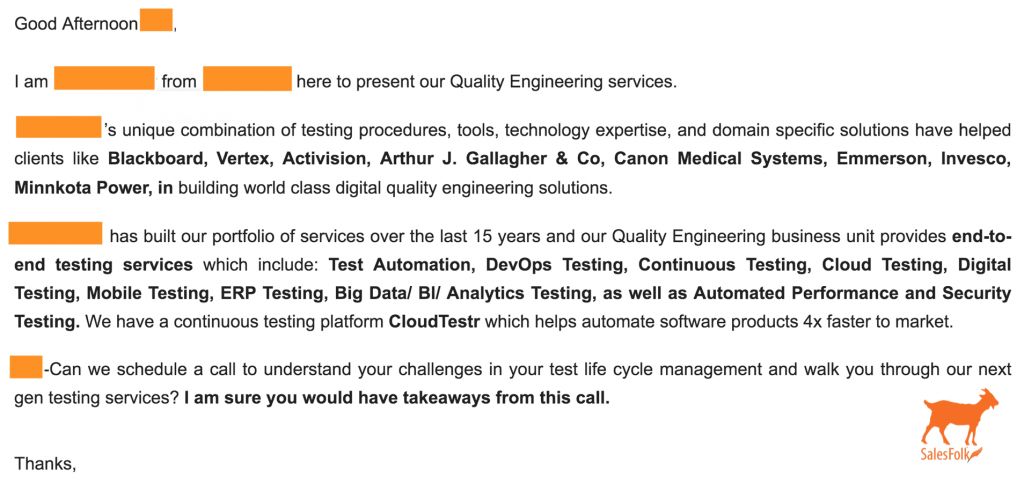Reaching out to leads via cold email can be intimidating at first. Your ego is on the line – will your message resonate with the people you want to start a sales conversation with, or will you be rejected or ignored?
If you’re selling to a broad range of titles and industries, it can be tempting to aim for the most generic message possible that could appeal to anyone on your list. Instead of narrowing down your audience and your value propositions, you pick the broadest reasons why someone would choose to buy your product or work with your company.
And it doesn’t work. It never does.
At least not with overwhelmingly positive results. You might get some responses, but if you’re sending untargeted, generic messages, you’re going to have more unsubscribes and spam complaints than appointments set.
And if you do get a response to a generic message, there’s a much higher chance that you’ll end up talking to an unqualified lead. Because they aren’t exactly sure what you’re trying to sell them, you end up sinking more time into explaining the value to them later on.
Plus, it doesn’t take long to damage your IP’s reputation enough that before you know it, none of your messages will get through. Not to mention you’ll be haphazardly burning through your lead list.
The reason overly generic messages fail is because, as humans, we crave specificity — even more so when we’re thinking about spending money, or investing time into starting a relationship with a new person.
Here are three cold email mistakes related to generic messages, and what the sender should have tried instead.
1. Vague descriptors ruin sales conversations
First up, we have an email so vague that you can barely tell what’s being sold:
Hello there,
I wanted to check in to hear more about your marketing software needs at Salesfolk. Do you think we could be of any help?
It’s fairly easy to see why this cold email doesn’t pack a punch. What kind of marketing software is this person selling, and who is it for? What do I stand to gain if I decide to take the time to respond to them?
Instead, this writer should have narrowed in on one specific benefit that’s clear and compelling. If she’s selling a marketing analytics platform, perhaps that benefit might be “spend less time manually crunching numbers in Excel” or “manage your quarterly budgets 2x as fast”. Both of those benefits are likely to be relatable enough to really persuade someone that they need to respond.
2. Emails with long, boring feature lists turn off sales prospects
Feature lists are some of the most generic things around. It’s like shooting at a target without aiming and hoping, against all odds, that one arrow hits the bullseye and makes a lead go “Yes! That’s a thing I need.”
Here’s one example of a long, long list of services in an already long email:

At least they aren’t using bullet points, but WOW. That’s a lot to take in.
Instead of inundating the reader with a list of clients and a list of the millions of things you can do, just talk about one success story. Keep it short – no more than two or three sentences – and save customer quotes for your landing page.
3. Sending too few follow-up emails leaves money on the table
After careful, data-driven research, we’ve determined that the optimal number of emails you should be sending each campaign is eight. Sending 7 follow-ups sounds simple, right? Just write “Hey, I’m following up, see my previous message, when do you have time for a call…”
Unfortunately, that’s not likely to get you the results you’re looking for.
In fact, sending a bunch of following emails on the same thread that say you’re “just following up” makes you more likely to get spam complaints. And it doesn’t add anything of value to your prospect’s life – you’re essentially standing there nagging them to get back to you.
Every single follow up email you send should contain a unique benefit or piece of information. Not all your benefits will appeal to every single person on your list. Different people in your audience will have different priorities and pain points, but that’s partly why you have eight emails to see what they respond to, since peoples’ taste and situations will vary.
The best way to do this is by outlining your campaign before you start writing. Here’s a piece of an outline I made for a recent cold email campaign.
Email 1 – Spend more time with guests
Email 2 – Stop wasting your time taking reservations by hand
Email 3 – Lower your per guest cost
For example, Email 3 might be the most popular email in our sequence, meaning it gets the most positive responses.
However, perhaps Email 1 gets fewer responses than other emails, but the people who do respond tend to result in deals that close very fast.
You won’t know for sure until you test the email campaign and analyze its results. However, the best way to appeal to the most people in your list is by sending a series of emails that focus on different specific benefits, ideas, or pain points.
If you’d like to learn more about how to infuse specific, alluring benefits into your cold email templates, you might want to check out our new Cold Email Crash Course.
We boiled down everything we learned from thousands of hours spent teaching folks to write cold emails that earned our clients millions in sales into just 10 lessons. Hope to see you there!
The post 3 Cold Email Mistakes That Ruin Sales Conversations appeared first on SalesFolk.

